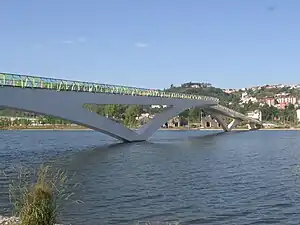
The Pedro e Inês bridge is a footbridge opened in 2007 in the town of Coimbra in Portugal. It was designed by Cecil Balmond, Arup Group, and Portuguese civil engineer António Adão da Fonseca.
Spanning the Rio Mondego, the 600 feet (180 m) structure is the city's first footbridge and has become locally known as the "bridge that doesn't meet."
Partly inspired by skipping stones,[1] the design is created from two cantilevered walkways joining in the middle.[2] Each walkway is responsible for supporting the other - the two halves are displaced, giving the visual effect of a bridge that does not meet.[3] Wallpaper magazine said the bridge "appears at first glimpse to be impossible."[2] The balustrade is made from a clear, fractal pattern crafted in coloured blue, pink, green and yellow glass.[4]
The bridge is named for the ill-fated affair between Pedro, the Crown Prince of Portugal, and the Queen's lady-in-waiting, Inês de Castro.
References
- ↑ "Thinking Outside the Box". Business Week. Archived from the original on 2008-10-07. Retrieved 2010-09-20.
- 1 2 "Coimbra bridge, Cecil Balmond | Architecture | Wallpaper* Magazine". Wallpaper. Archived from the original on 2010-08-20. Retrieved 2010-09-20.
- ↑ Nicolai Ouroussoff (26 November 2006). "An Engineering Magician, Then (Presto) He's an Architect". The New York Times.
- ↑ "Cecil Balmond and the Bonfire of the Vanities". LynnBecker.com.
External links
- Work - Pedro e Inês, Balmond Studio
- Footbridge over the river Mondego "Pedro e Inês", afaconsult
- Pedro and Inês Bridge at Structurae. Retrieved 2018-09-21.
- Business Publications
- Arup journal
- "Dawdle this way". The Guardian. 11 December 2006.